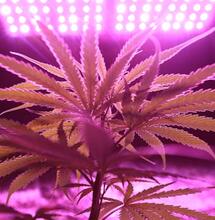Green Manure

The cultivation of leguminous plants alongside organic outdoor cannabis improves the microbial life and structure of the soil. This organic fertilizer, also known as "green manure", uses airborne nitrogen to keep the soil healthy and rich in nutrients. Exactly what you need if you have gone down the Organic or Veganic route.
Plants from the Fabaceae family (Leguminosae) have nitrogen-fixing Rhizobium bacteria inside their root nodules. These bacteria supply nitrogen to the plant and, in return, receive carbon. The good news is that surrounding plants also benefit from soil nitrogen accumulation.
There are two ways to use these bacteria to your advantage. You can grow legumes and cannabis alongside each other. Alternatively, you can
sow your cannabis plants once the leguminous plants have broken down, which is when they will release all the nitrogen inside their cell bodies. They're the only plants capable of carrying out this process naturally, and that is why they got the name "green manure".
Growing leguminous plants near a cannabis crop improve microbial life in the soil and the soil structure. Leguminous plants have a robust root system that can go as deep as 6-10 ft into the ground. Consequently, soil aeration is enhanced, allowing water and nutrients to move more freely. This also means that the roots of the cannabis plants can still stretch out without restriction as their roots are much shallower and more lateral.
Here are eight leguminous plants that act as green manure and help to restore soil balance in organic cannabis crops.
White clover or Dutch clover is a perennial plant with whitish flowers that grows no more than 4 inches high and will evenly cover an entire area. White clover is commonly grown in grassy areas where cows graze since it can boost milk production. It is excellent in its ability to fix nitrogen.
Cow vetch is a herbaceous plant with climbing stems that can grow up to 5 ft. When in Flower, it produces blueish purple spiky-looking flowers. Cow vetch has nitrogen-fixing and can improve soil structure.
- Alfalfa is a perennial plant that grows to a height of between 12 and 31 inches. In Flower, it produces nectar-filled flowers that honeybees love. Most alfalfa varieties have purple flowers that look like pompoms. Alfalfa Arborea is also a great choice. Its deep-burrowing roots improve soil aeration and help fix nitrogen in the soil. Alfalfa Arborea is also particularly resistant to draughts.
- Phacelia this plant is nectar-rich and acts as a natural herbicide that can quickly eliminate weeds, thanks to its fast growth.
- White mustard grows so fast that surrounding weeds are stopped dead in their tracks. It repels any nematodes and fungi that may attack the root system, takes up nitrogen and is hardy to cold and frosty climates. As if that was not enough, it's also easy to grow.
- Blue lupin is a very effective nitrogen-fixing plant making it great for tired soil that has been overused. In Bloom, it produces blue clusters of flowers.
- Bird's foot trefoil is a melliferous plant that makes a great multi-annual 'green manure. As well as being drought-resistant and cold-resistant, it thrives in calcium-rich soils, improving aeration and fixing nitrogen.
- Crimson Clover, with its blood-red flowers, is both beautiful and practical. A fast-growing plant that fixes nitrogen improves aeration and prevents weeds from developing. It can quickly adapt to all varieties of soils.


_0.jpg)

